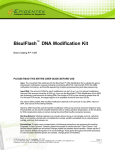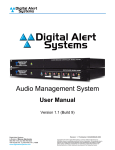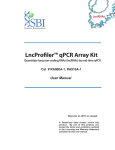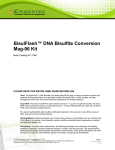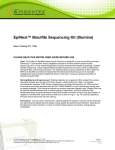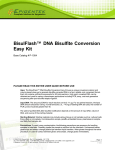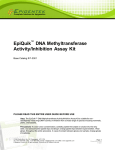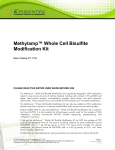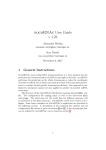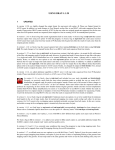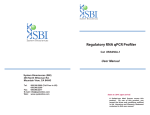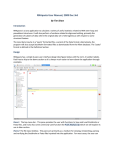Download Methylamp™ RNA Bisulfite Conversion Kit
Transcript
EPIGENTEK Complete Solutions for Epigenetics Methylamp™ RNA Bisulfite Conversion Kit Base Catalog # P-9003 PLEASE READ THIS ENTIRE USER GUIDE BEFORE USE Uses: The converted RNA obtained with the Methylamp™ RNA Bisulfite Conversion Kit is suitable for various downstream RNA methylation analyses including methylation specific RT-PCR, MS-HRM, and bisulfite-sequencing including pyrosequencing and deep-sequencing. Input RNA: The amount of RNA for each bisulfite reaction can be 5 ng-1 µg. For an optimal reaction, the input RNA amount should be 200-500 ng. When using the Methylamp™ RNA Bisulfite Conversion Kit for methylation-specific RT-PCR with very small amounts of input RNA (<10 ng), the number of PCR cycles should be greater than 45. The yield of RNA purified after bisulfite conversion depends on the amount of input RNA, nature of RNA, and source of the starting material. Starting Material: RNA isolated from various tissue or cell samples can be used as starting material. Precautions: To avoid cross-contamination, the following precautions are necessary for handling Epigentek F-Spin Columns: Carefully pipette the sample or solution into the F-Spin Column. Use aerosol-barrier pipette tips and always change pipette tips between liquid transfers. Always cap the FSpin Columns before placing them in a microcentrifuge. Wear gloves throughout the entire procedure. In case of contact between gloves and sample, change gloves immediately. 110 Bi County Blvd. Ste. 122, Farmingdale, NY 11735 Tel: 1-877-374-4368 ■ Fax: 1-718-484-3956 ■ E-mail: [email protected] ■ Web: www.epigentek.com © Epigentek Group Inc. All rights reserved. Products are for research use only. Page 1 Printed 2013-12-20 P-9003 EPIGENTEK Complete Solutions for Epigenetics KIT CONTENTS Component 50 reactions Cat. #P-9003-050 Storage Upon Receipt Conversion Buffer Conversion Powder NA Binding Solution F-Spin Column* F-Collection Tube Desulphonation Solution Control Primer-F (10 uM) 8 ml 5 vials 13 ml 50 50 300 µl 10 µl RT RT RT RT RT RT -20°C Control Primer-R (10 uM) 10 µl -20°C Elution Buffer 1.2 ml RT User Guide 1 RT * Always cap spin columns before placing them in the microcentrifuge. SHIPPING & STORAGE The kit is shipped on frozen ice packs at 4°C. Upon receipt: (1) Store the following components at -20°C immediately: Control Primer-F and Control Primer-R. Store all other components at room temperature. The kit is stable for up to 6 months from the shipment date, when stored properly. MATERIALS REQUIRED BUT NOT SUPPLIED Thermocycler with heated lid* *Since the bisulfite reaction is not overlaid with mineral oil, only thermal cyclers with heated lids are suitable for this procedure. Desktop centrifuge (up to 14,000 rpm) Pipette and pipette tips 0.2 ml PCR tubes 1.5 ml microcentrifuge tubes 100% ethanol RNA sample 110 Bi County Blvd. Ste. 122, Farmingdale, NY 11735 Tel: 1-877-374-4368 ■ Fax: 1-718-484-3956 ■ E-mail: [email protected] ■ Web: www.epigentek.com © Epigentek Group Inc. All rights reserved. Products are for research use only. Page 2 Printed 2013-12-20 P-9003 EPIGENTEK Complete Solutions for Epigenetics GENERAL PRODUCT INFORMATION Quality Control: Each lot of Methylamp™ RNA Bisulfite Conversion Kit is tested against predetermined specifications to ensure consistent product quality. Epigentek guarantees the performance of all products in the manner described in our product instructions. Product Warranty: If this product does not meet your expectations, simply call our technical support unit or your regional distributor. We also encourage you to contact us if you have any suggestions about product performance or new applications and techniques. Safety: Suitable lab coat, disposable gloves, and proper eye protection are required when working with this product. Product Updates: Epigentek reserves the right to change or modify any product to enhance its performance and design. Usage Limitation: The Methylamp™ RNA Bisulfite Conversion Kit is for research use only and is not intended for diagnostic or therapeutic application. Intellectual Property: The Methylamp™ RNA Bisulfite Conversion Kit and methods of use contain proprietary technologies by Epigentek. A BRIEF OVERVIEW DNA cytosine methylation occurs by the covalent addition of a methyl group at the 5-carbon of the cytosine ring by DNA methyltransferases, resulting in 5-methylcytosine (5-mC). This process has been well studied and is generally associated with repression of gene expression. It was also observed that in humans, 5-mC occurs in various RNA molecules including tRNAs, rRNAs, mRNAs and non-coding RNAs (ncRNAs). At least 10,275 5-mC candidate sites were discovered in mRNAs and ncRNAs, which covered 10.6% of the total cytosine residues in the transcriptome. 5-mC seems to be enriched in some classes of ncRNA, but relatively depleted in mRNAs. However, the majority (83%) of their candidate sites were found in mRNAs. Within these transcripts 5-mC appears to be depleted within protein coding sequences but enriched in 5’ and 3’ UTRs. Two different methyltransferases, NSUN2 and Dnmt2 are known to catalyze the 5-mC modification in eukaryotic RNAs. Recent data strongly suggest that RNA cytosine methylation affects the regulation of various biological processes such as RNA stability and mRNA translation. Furthermore, loss of 5-mC in vault RNAs causes aberrant processing into Argonaute-associated small RNA fragments that can function as microRNAs. Thus, impaired processing of vault ncRNA may contribute to the etiology of human disorders related to NSUN2deficiency. Bisulfite conversion of RNA followed by RT-PCR amplification, cloning, and sequencing yields reliable information about RNA cytosine methylation states. By treating RNA with bisulfite, cytosine residues are deaminated to uracil while leaving 5-methylcytosine intact: Unmethylated RNA Original Sequence After Bisulfite Conversion C-C-U-C-G-A-C-U U-U-U-U-G-A-U-U Methylated RNA C-C-U-MC-G-A-MC-U U-U-U-MC-G-A-MC-U To effectively and efficiently prepare converted RNA for use in various downstream analyses, Epigentek developed the Methylamp™ RNA Bisulfite Conversion Kit. The kit is specifically optimized and validated for bisulfite conversion of RNA and has the following advantages and features: 110 Bi County Blvd. Ste. 122, Farmingdale, NY 11735 Tel: 1-877-374-4368 ■ Fax: 1-718-484-3956 ■ E-mail: [email protected] ■ Web: www.epigentek.com © Epigentek Group Inc. All rights reserved. Products are for research use only. Page 3 Printed 2013-12-20 P-9003 EPIGENTEK Complete Solutions for Epigenetics Fast and convenient protocol that can be finished in 3 hours. Completely converts unmethylated cytosine into uracil (>99.9%) with no or negligible inappropriate/error conversion of methylcytosine to thymine (<0.1%) when the indicated range of sample RNA is used. Powerful protection against RNA degradation, with over 90% of RNA loss prevented. Included control primers are specific against bisulfite-converted RNA and can be used to test if the bisulfite conversion has been properly achieved. Low amount of input RNA can be used for bisulfite conversion - as low as 5 ng per reaction. Simple, reliable, and consistent reaction conditions. PRINCIPLE & PROCEDURE The Methylamp™ RNA Bisulfite Conversion Kit contains all reagents required for fast bisulfite conversion on a RNA sample. The unique conversion mix solution contains powerful RNA protection reagents to prevent chemical and thermophilic degradation, thus leading to an accelerated conversion of all cytosines to uracil with negligible methylcytosine deamination. The non-toxic RNA capture solution enables RNA to tightly bind to the column filter, so that converted RNA cleaning can be carried out on the column to effectively remove residual bisulfite and salts. Fig 2. RNA bisulfite sequencing analysis: RNA isolated from MCF-7 cells is subject to bisulfite treatment, cDNA synthesis and sequencing after PCR amplification using 28S rRNA primers specific for bisulfite converted RNA. Unmethylated cytosines (#4, 5, 14) are converted to uracil and detected as thymine while methylated cytosine (#8) remains the same. Fig 1. Schematic procedure of the Methylamp™ RNA Bisulfite Conversion Kit to obtain converted RNA. 110 Bi County Blvd. Ste. 122, Farmingdale, NY 11735 Tel: 1-877-374-4368 ■ Fax: 1-718-484-3956 ■ E-mail: [email protected] ■ Web: www.epigentek.com © Epigentek Group Inc. All rights reserved. Products are for research use only. Page 4 Printed 2013-12-20 P-9003 EPIGENTEK Complete Solutions for Epigenetics ASSAY PROTOCOL For the best results, please read the protocol in its entirety prior to starting your experiment. Starting Materials Input RNA Amount: RNA amount can range from 5 ng to 1 μg per reaction. An optimal amount is 200– 500 ng per reaction. Starting RNA may be in water or in a buffer such as TE. RNA should be high quality and relatively free of DNA. DNAse I can be used to remove DNA and RNA should be eluted in RNase-free water. RNA Storage: RNA should be stored at -20°C or -80°C until use. 1. Working Buffer and Solution Preparation a. Prepare Conversion Solution: Add 1.4 ml of Conversion Buffer and 40 µl of Desulphonation Solution to 1 vial of Conversion Powder to generate conversion solution. Mix by inverting and shaking the vial repeatedly for 3-4 min (trace amount of undissolved Conversion Powder may remain, which is normal as Conversion Powder is saturated in solution). b. Prepare 70% ethanol by adding 3 ml of distilled water to 7 ml of 100% ethanol. c. Prepare 90% ethanol by adding 1ml of distilled water to 9 ml of 100% ethanol. d. Prepare working desulphonation buffer: First dilute Desulphonation Solution at a 1:12 ratio by adding 5 µl of Desulphonation Solution to 55 µl of distilled water. Next, add 2 µl of Diluted Desulphonation Solution to every 1 ml of 90% ethanol, and mix. 2. RNA Bisulfite Conversion a. Add 100 µl of the conversion solution to a PCR tube followed by adding 2-10 µl of RNA sample. Prepared conversion solution can be stored at -20°C for up to 2 weeks without significant loss of efficiency. For the best results, the mixed solution should be used immediately. b. Tightly close the PCR tubes and place them in a thermal cycler with heated lid. Program and run the thermal cycler : 65°C 5 min 60°C 90 min Hold 4°C up to 16 h Meanwhile, insert the number of F-Spin Columns into F-Collection Tubes as needed by your experiment. 110 Bi County Blvd. Ste. 122, Farmingdale, NY 11735 Tel: 1-877-374-4368 ■ Fax: 1-718-484-3956 ■ E-mail: [email protected] ■ Web: www.epigentek.com © Epigentek Group Inc. All rights reserved. Products are for research use only. Page 5 Printed 2013-12-20 P-9003 EPIGENTEK Complete Solutions for Epigenetics 3. Converted RNA Clean-Up a. Add 250 µl of NA Binding Solution to each column. Then transfer the samples from each PCR tube (from Step 2b) to each column containing the NA Binding Solution. Centrifuge at 12,000 rpm for 1 min. Remove columns from collection tubes and discard the flowthrough. Place columns back into collection tubes. b. Add 200 µl of 70% ethanol solution to each column. Centrifuge at 12,000 rpm for 1 min. c. Add 200 µl of the working desulphonation buffer (Desulphonation Solution and 90% ethanol mixture according to Step 1d) to each column. Allow columns to sit for 30 min at room temperature, then centrifuge at 12,000 rpm for 1 min. Remove columns from collection tubes and discard the flowthrough. Place columns back into collection tubes. d. Add 200 µl of 90% ethanol to each column. Centrifuge at 12,000 rpm for 1 min. Remove columns from collection tubes and discard the flowthrough. Place columns back into collection tubes. Add 200 µl of 90% ethanol to each column again and centrifuge at 12,000 rpm for 1 min. e. Insert each column into a new 1.5 ml tube. Add 10-20 µl of Elution Buffer directly to each column’s filter membrane. Centrifuge at 12,000 rpm for 1 min to elute converted RNA. Converted RNA is now ready for use, or storage at or below –20°C for up to 2 months. As the bisulfitetreated RNA is not stable, we recommend performing cDNA synthesis from bisulfite-treated RNA before next application or storage. See appendix I for cDNA synthesis. Appendix 1. cDNA Synthesis You can use your method of choice for cDNA synthesis. For your convenience, Epigentek offers EpiNext™ Hi-Fi cDNA Synthesis Kit (Cat # 9004) which is optimized and validated for synthesis of cDNA from bisulfite RNA. a. Add the following in a 0.2-ml PCR tube on ice: Component Amount Bisulfite-converted RNA (200-500 ng) 10 µl Random primer (50 uM) 1 µl 10 mM dNTP mix 1 µl b. Heat in a thermocycler (no heated lid) at 65°C for 3 minutes. Place on ice immediately for at least 1 minute. c. Add the following to the tube on ice: 110 Bi County Blvd. Ste. 122, Farmingdale, NY 11735 Tel: 1-877-374-4368 ■ Fax: 1-718-484-3956 ■ E-mail: [email protected] ■ Web: www.epigentek.com © Epigentek Group Inc. All rights reserved. Products are for research use only. Page 6 Printed 2013-12-20 P-9003 EPIGENTEK Complete Solutions for Epigenetics Component Amount 5X RT Reaction Buffer 4 µl 0.1M DTT 2 µl RNase Inhibitor 1 µl RT Enzyme Mix 1 µl Total Volume 20 µl Vortex the sample briefly to mix and collect by centrifugation. Incubate as follows: 42˚C for 45 min followed by 80˚C for 5 min (no heated lid). Store the cDNA synthesis reaction at -20°C, or proceed directly to next application such as methylation specific PCR (see Appendix 2 “Working with Methylation Specific qPCR”) or bisulfite-sequencing. 2. Working with Methylation Specific qPCR When working with methylation specific-PCR, we recommend using the Methylamp™ MS-qPCR Fast Kit (Cat # P-1028) which contains a hot start polymerase system and has been optimized to decrease the overall methylation specific-qPCR amplification time. The master mix is provided at a 2X concentration for easier preparation of PCR reactions requiring only the addition of primers and templates. With this kit, the MS-qPCR can be finished in as short as 70 min. Prepare the PCR Reactions Component Size (µl) Final Concentration Methylamp Master Mix (2X) 10 µl 1X Forward Primer 1 µl 0.4-0.5 µM Reverse Primer 1 µl 0.4-0.5 µM cDNA Template 1-2 µl 50 pg-0.1 µg RNase-free H2O 6-7 µl Total Volume 20 µl For the negative control, use RNase-free water instead of cDNA template. Program the PCR Reactions Cycle Step Temp Time Cycle Activation 95°C 7 min 1 Cycling 95°C 55°C 72°C 10 sec 10 sec 8 sec 40-45 Final Extension 72°C 1 min 1 110 Bi County Blvd. Ste. 122, Farmingdale, NY 11735 Tel: 1-877-374-4368 ■ Fax: 1-718-484-3956 ■ E-mail: [email protected] ■ Web: www.epigentek.com © Epigentek Group Inc. All rights reserved. Products are for research use only. Page 7 Printed 2013-12-20 P-9003 EPIGENTEK Complete Solutions for Epigenetics TROUBLESHOOTING Problem Possible Causes Suggestions RNA is poorly modified Poor RNA quality (RNA is severely degraded). Check if the sample RNA 260/280 ratio is between 1.9 - 2.0. Too little RNA or too much RNA (i.e., < 1ng or >1 µg). Increase or decrease input RNA to within the correct range, or to the optimal amount of 200-500 ng. Temperature or thermal cycling condition is incorrect. Check for appropriate temperature or thermal cycling conditions. Insufficient RNA clean-up. Ensure that 2 µl of diluted Desulphonation Solution is added into every 1 ml of 90% ethanol in Step 1d. Kit is not stored or handled properly. Store all components of the kit at room temperature. Poor input RNA quality (degraded). Check if RNA is degraded. NA Binding Solution is not added into the sample. Ensure that NA Binding Solution is added in Step 3a. Concentration of ethanol solution used for RNA clean-up is not correct. Use 90% ethanol for RNA clean-up. Little or no PCR product even in positive control. Ensure that cDNA synthesis is properly performed. Eluate contains little or no RNA Poor results in downstream methylation-specific qRT-PCR Ensure that all PCR components were added and that suitable PCR program is used (PCR cycle should be >40). PCR primers and probes were not appropriate or were incorrectly designed. Ensure the primer and probes are suitable for MS-PCR. Significant non-specific PCR products. Failed bisulfite conversion. Ensure that all steps of the bisulfite treatment and cleanup protocol were followed and that input RNA amount is within the recommended range. Primers and probes are not specific for converted RNA and target genes. Check the primer and probe design. 110 Bi County Blvd. Ste. 122, Farmingdale, NY 11735 Tel: 1-877-374-4368 ■ Fax: 1-718-484-3956 ■ E-mail: [email protected] ■ Web: www.epigentek.com © Epigentek Group Inc. All rights reserved. Products are for research use only. Page 8 Printed 2013-12-20 P-9003 EPIGENTEK Complete Solutions for Epigenetics RELATED PRODUCTS DNA Bisulfite Modification P-1001 Methylamp™ DNA Modification Kit P-1010 Methylamp™ One-Step DNA Modification Kit P-1016 Methylamp™ Whole Cell Bisulfite Modification Kit P-1026 BisulFlash™ DNA Modification Kit cDNA Synthesis P-9004 EpiNext™ Hi-Fi cDNA Synthesis Kit Methylation Analysis P-1028 Methylamp™ MS-qPCR Fast Kit 110 Bi County Blvd. Ste. 122, Farmingdale, NY 11735 Tel: 1-877-374-4368 ■ Fax: 1-718-484-3956 ■ E-mail: [email protected] ■ Web: www.epigentek.com © Epigentek Group Inc. All rights reserved. Products are for research use only. Page 9 Printed 2013-12-20 P-9003









